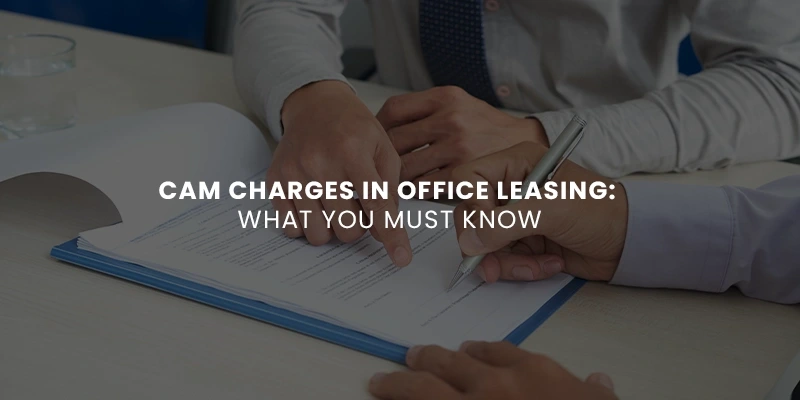CAM Charges in Office Leasing: What You Must Know
When evaluating a commercial office space, most tenants tend to focus on the rent per square foot. A property quoted at ₹75/sq.ft/month might immediately sound like a great deal. But what many overlook is a recurring additional cost that can significantly impact the overall lease expense: CAM charges — short for Common Area Maintenance.
And today, CAM charges are no longer just a footnote in the lease agreement. In many buildings, they can account for 20–40% of your total monthly outflow. In other words, CAM is the new rent — and it’s time we treated it that way.
What Are CAM Charges?
CAM (Common Area Maintenance) refers to the cost of maintaining shared spaces in a commercial building — spaces that every tenant benefits from but no one occupies individually. This includes:
- Lobby and reception areas
- Elevators and staircases
- Restrooms and corridors
- Parking facilities
- Common lighting, landscaping, and security
- Maintenance of HVAC systems and generator back-up
- Facility management salaries
- Building-level amenities like cafés, gyms, or lounges
In short, CAM is the operational cost of keeping the building functional, secure, and presentable.
The Problem: CAM Is Often Under-Discussed
What makes CAM tricky is that it's not always presented clearly during lease negotiations. A tenant may be quoted a rent of ₹70 per sq.ft and assume that’s the total cost. But once CAM (say ₹25 per sq.ft) is added, the effective cost becomes ₹95 per sq.ft — a 35% jump.
Worse still, CAM charges are variable. They can change annually, or even quarterly, based on inflation, electricity tariffs, staff salaries, fuel costs, and more. And unless it’s clearly defined in the agreement, tenants often have little control over how it's calculated.
CAM Charges: Real-World Impact
Let’s take a real example.
You lease a 5,000 sq.ft office in a premium Grade A building:
- Base Rent: ₹75/sq.ft
- CAM: ₹25/sq.ft
- Monthly Base Rent: ₹3,75,000
- Monthly CAM: ₹1,25,000
- Total Monthly Cost: ₹5,00,000
Over a 3-year lease, that’s ₹45 lakhs in CAM charges — often not anticipated during budgeting.
What CAM Charges Typically Include (and Sometimes Don’t)
While many costs are legitimate, here’s where tenants need clarity:
Standard Inclusions:
- Housekeeping, maintenance, and security
- Electricity in common areas
- DG power for lifts and lobby
- Landscaping and façade cleaning
- Repairs and upkeep of common infrastructure
Possible Add-ons (if not negotiated properly):
- Amenities like conference rooms, gyms, and cafeterias
- Clubhouses or recreational areas
- Marketing expenses for the building
- Contributions to capital repairs or future upgrades
Tip: Always request a detailed CAM breakup before signing. Some landlords bundle in items that may not be relevant to your use.
How CAM Is Calculated
Most often, CAM is calculated per sq.ft/month, either based on:
- Carpet Area: The actual usable area inside your unit
- Built-Up Area: Carpet area + walls
- Super Built-Up Area: Includes your unit’s share of common areas
In many leases, CAM is applied on the super built-up area — meaning you’re paying for more than just what you occupy. If you don’t negotiate this, your effective cost may be higher than expected.
Comparing CAM Trends Across Cities
Based on recent market data (2025), here are average CAM charges in top Indian cities (Grade A commercial buildings):
City
Avg. CAM Charges (₹/sq.ft/month)
Bengaluru
₹20–₹30
Mumbai (BKC)
₹28–₹40
Gurugram
₹22–₹35
Hyderabad
₹15–₹22
Pune
₹14–₹20
Note: Buildings with premium amenities or managed campuses often fall on the higher end of this range.
CAM vs Gross Rent: Which is Better?
When evaluating office space options, you may come across two structures:
1. Base Rent + CAM
- Transparent, but variable
- Risk of unexpected hikes
- Requires active lease management
2. Gross Rent (All-inclusive)
- Fixed monthly cost
- Easier for budgeting
- Less room for dispute, but may include a buffer
Smart Strategy: If your team is lean or finance-sensitive, gross rent offers peace of mind. For larger enterprises with in-house legal/commercial teams, split rent + CAM gives room to negotiate separately.
Questions Every Tenant Should Ask Before Signing
- What are the current CAM charges, and what’s the breakup?
- Is there a cap on annual escalation?
- Is CAM charged on carpet, built-up, or super built-up area?
- Are future upgrades or major repairs included in CAM?
- Will CAM be reconciled annually? If yes, can I audit it?
How to Avoid CAM Shocks
- Get CAM estimates in writing: Don’t go by verbal assurances.
- Negotiate escalation limits: Try for a cap (e.g., 5–7% per year).
- Ask for sample invoices: Past CAM statements help set expectations.
- Clarify exclusions: Don’t pay for what you don’t use.
- Partner with advisors: A good real estate consultant can help you interpret clauses that aren’t always obvious.
CAM: A Necessary Cost, Not a Hidden One
Let’s be clear: CAM isn’t bad. In fact, well-managed CAM is the reason your elevator works, your guests are welcomed, and your team doesn’t trip on loose wires.
But problems arise when tenants aren’t told what they’re paying for, or when CAM escalations aren’t tracked.
With rising expectations from office buildings — central air-conditioning, 24x7 power, lounge spaces, gyms, security — operational costs are increasing. And naturally, those costs trickle down to tenants.
Conclusion
CAM is no longer a secondary line item. In modern office leasing, it can influence 25–40% of your total occupancy cost.
As an occupier, being aware of how CAM works — and negotiating it smartly — is no longer optional. It’s essential.
At The Office Address, we believe transparency in leasing isn’t a luxury — it’s a standard. And understanding CAM is a big part of that clarity.
Need help reviewing your lease or decoding CAM in your current space?
Talk to us — we help growing teams avoid financial surprises and secure long-term value.
